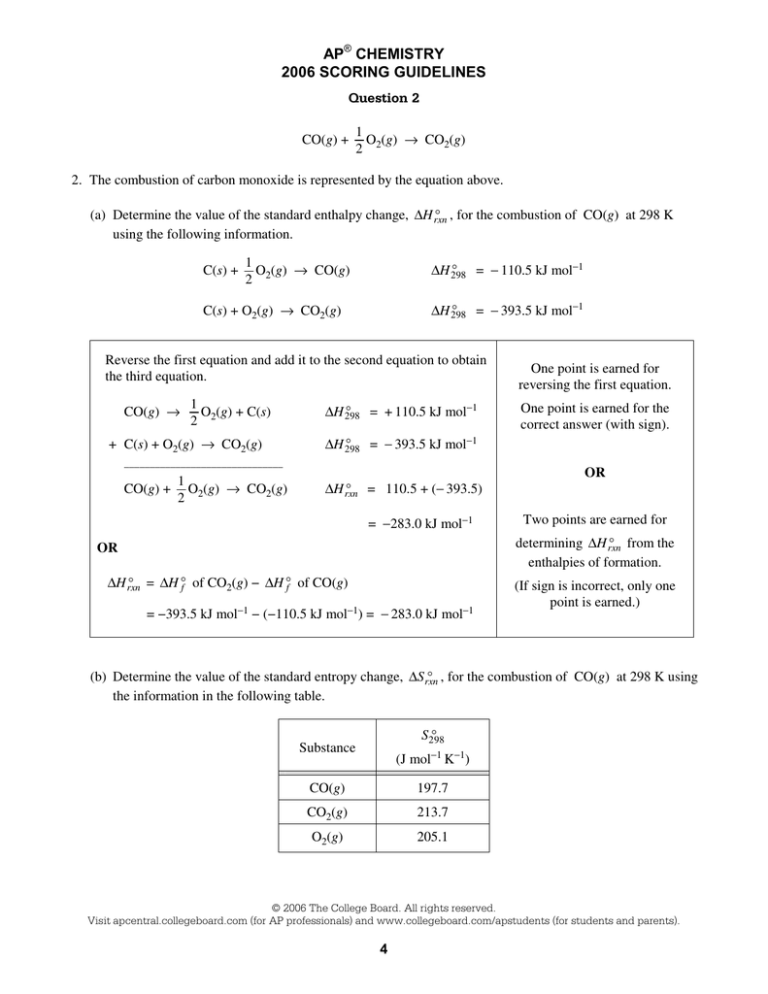
AP® CHEMISTRY
2006 SCORING GUIDELINES
Question 2
CO(g) +
1
O (g) → CO2(g)
2 2
2. The combustion of carbon monoxide is represented by the equation above.
D , for the combustion of CO(g) at 298 K
(a) Determine the value of the standard enthalpy change, ∆H rxn
using the following information.
C(s) +
1
O (g) → CO(g)
2 2
D = − 110.5 kJ mol−1
∆H 298
D = − 393.5 kJ mol−1
∆H 298
C(s) + O2(g) → CO2(g)
Reverse the first equation and add it to the second equation to obtain
the third equation.
CO(g) →
1
O (g) + C(s)
2 2
+ C(s) + O2(g) → CO2(g)
D = + 110.5 kJ mol−1
∆H 298
1
O (g) → CO2(g)
2 2
One point is earned for the
correct answer (with sign).
D = − 393.5 kJ mol−1
∆H 298
_______________________________
CO(g) +
One point is earned for
reversing the first equation.
D = 110.5 + (− 393.5)
∆H rxn
= −283.0 kJ mol−1
OR
OR
Two points are earned for
determining ∆H D from the
rxn
enthalpies of formation.
D = ∆H D of CO (g) − ∆H D of CO(g)
∆H rxn
f
f
2
= −393.5 kJ mol−1 − (−110.5 kJ mol−1) = − 283.0 kJ mol−1
(If sign is incorrect, only one
point is earned.)
D , for the combustion of CO(g) at 298 K using
(b) Determine the value of the standard entropy change, ∆S rxn
the information in the following table.
D
S298
Substance
(J mol−1 K−1)
CO(g)
197.7
CO2(g)
213.7
O2(g)
205.1
© 2006 The College Board. All rights reserved.
Visit apcentral.collegeboard.com (for AP professionals) and www.collegeboard.com/apstudents (for students and parents).
4
AP® CHEMISTRY
2006 SCORING GUIDELINES
Question 2 (continued)
D = 213.7 J mol−1 K−1 − (197.7 J mol−1 K−1 +
∆S rxn
= − 86.5 J
1
(205.1 J mol−1 K−1))
2
mol−1 K−1
One point is earned for
taking one-half of S D
298
for O2(g).
One point is earned for the
answer (with sign).
D , for the reaction at 298 K. Include units with
(c) Determine the standard free energy change, ∆Grxn
your answer.
One point is earned for substituting
the values from parts (a) and (b)
into the equation.
D = ∆H D − T ∆S D
∆Grxn
rxn
rxn
= −283.0 kJ mol−1 − (298 K)(− 0.0865 kJ mol−1 K−1)
D = −257.2 kJ mol−1
∆Grxn
One point is earned for the answer
(with sign and units).
(d) Is the reaction spontaneous under standard conditions at 298 K ? Justify your answer.
Yes, the reaction is spontaneous because the value
of ∆G D for the reaction is negative (−257.2 kJ mol−1).
rxn
One point is earned for an answer
with justification (consistent with the
answer in part (c)).
(e) Calculate the value of the equilibrium constant, Keq , for the reaction at 298 K.
D = −R T ln K
∆Grxn
eq
⇒
-257,200 J mol -1
-(8.31 J mol -1 K -1 )(298 K)
D
∆Grxn
= ln Keq
− RT
= ln Keq
⇒
One point is earned for correct
substitution into the equation.
Keq = 1.28 × 1045
One point is earned for the answer.
© 2006 The College Board. All rights reserved.
Visit apcentral.collegeboard.com (for AP professionals) and www.collegeboard.com/apstudents (for students and parents).
5
© 2006 The College Board. All rights reserved.
Visit apcentral.collegeboard.com (for AP professionals) and www.collegeboard.com/apstudents (for students and parents).
© 2006 The College Board. All rights reserved.
Visit apcentral.collegeboard.com (for AP professionals) and www.collegeboard.com/apstudents (for students and parents).
© 2006 The College Board. All rights reserved.
Visit apcentral.collegeboard.com (for AP professionals) and www.collegeboard.com/apstudents (for students and parents).
© 2006 The College Board. All rights reserved.
Visit apcentral.collegeboard.com (for AP professionals) and www.collegeboard.com/apstudents (for students and parents).
© 2006 The College Board. All rights reserved.
Visit apcentral.collegeboard.com (for AP professionals) and www.collegeboard.com/apstudents (for students and parents).
© 2006 The College Board. All rights reserved.
Visit apcentral.collegeboard.com (for AP professionals) and www.collegeboard.com/apstudents (for students and parents).
AP® CHEMISTRY
2006 SCORING COMMENTARY
Question 2
Overview
The intent of this question was to test students’ knowledge of basic thermodynamic relationships, including
enthalpy, entropy, and free energy changes, and the equilibrium constant associated with a chemical reaction. The
first task was to calculate the values for enthalpy, entropy, and free energy changes from the information
provided. Students were asked what the calculated thermodynamic quantities implied for the spontaneity of the
reaction given, CO + ½ O2 → CO2 , and had to calculate the thermodynamic equilibrium constant.
Sample: 2A
Score: 9
This response earned all 9 points: 2 points for part (a), 2 points for part (b), 2 points for part (c), 1 point for part
(d), and 2 points for part (e). Note that the student has an unusual way of writing the numeral “8,” which is
consistently used throughout the response.
Sample: 2B
Score: 7
Only 1 point was earned in part (c) because the negative sign in (−.0866 kJ/mol K) is not carried through
correctly, constituting a math error. The point was not earned in part (d) because of the incorrect conclusion that
a negative Gibbs free energy is an indication of nonspontaneity.
Sample: 2C
Score: 5
Only 1 point was earned in part (b) because the entropy of oxygen is not multiplied by ½, its coefficient in the
combustion equation. This incorrect value is used correctly in part (c), but only 1 out of 2 points were earned in
this part because the number of significant figures in the answer is off by more than one. In part (d) 1 point was
earned, but part (e) is not attempted.
© 2006 The College Board. All rights reserved.
Visit apcentral.collegeboard.com (for AP professionals) and www.collegeboard.com/apstudents (for students and parents).


